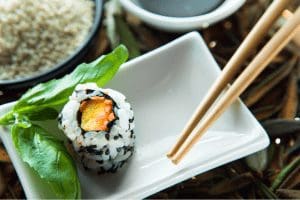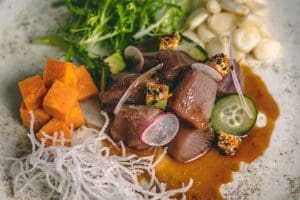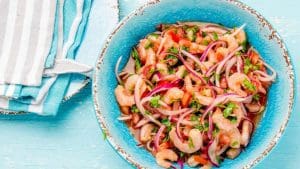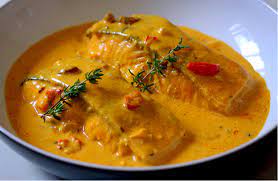
Have you ever tried fish dishes that taste amazing and a bit different from what you’re used to? Well, that’s because chefs all around the world have been mixing the flavors and cooking styles of Asia with fish, creating something really special. In this article, we’re going to explore these tasty combinations and learn about how different cultures have blended their cooking ideas with Asian influences to make fish dishes that are super delicious! So, let’s dive in and discover these exciting culinary fusions!
Contents
Exploring Sushi Beyond Japan: A Delicious Adventure🐟
Hey there, food explorers! Today, we’re diving into the world of sushi, but not just any sushi – we’re talking about how this amazing Japanese dish has traveled the globe and made some exciting new friends.
A Short Tale of Japanese Sushi:
First, let’s take a step back in time. Sushi, originally from Japan, is a super cool way of serving fish with rice. It’s been around for centuries! Japanese chefs crafted sushi as a tasty way to preserve fish with a sprinkle of salt. They put it in rice and let it ferment, which might sound a bit weird, but trust me, it’s delicious!
How Sushi Became a Global Sensation:
Now, let’s fast-forward to today. Sushi isn’t just enjoyed in Japan anymore. Nope, it’s spread its tasty tentacles all over the world! People everywhere have fallen in love with these flavorful bites.
Imagine this: chefs from different countries decided to give sushi their own twist by using Asian fish recipes and other local ingredients. They created something new and exciting, making sushi even more amazing.
Sushi Meets Local Flavors:
In some places, they added a touch of their own culture to sushi. For example, in America, you might find sushi rolls with avocado or cream cheese. Yep, that’s a far cry from traditional Japanese sushi, but oh boy, it’s good!
Global Sushi Adventures:
Now, let’s hop on a sushi world tour!
- Sushi in the USA: In the United States, you can find sushi with a wide range of ingredients. Some rolls have cooked fish, while others have veggies like cucumber or carrots. They get creative with names too, like “California Roll.”
- Sushi in Mexico: Ever heard of a sushi burrito? It’s like a giant sushi roll, and it’s a big hit in Mexico. They fill it with all sorts of deliciousness, including fresh seafood.
- Sushi in Brazil: Brazil introduced a unique sushi roll called “Temaki.” It’s like a sushi ice cream cone filled with fresh fish, rice, and veggies. Yum!
- Sushi in South Korea: In Korea, they have “Gimbap,” which is similar to sushi but with different fillings like beef, pickled radish, and egg. It’s like a sushi cousin!
Ceviche Nikkei.🐟
Hey there, young foodies! Today, we’re embarking on a taste adventure in Latin America, exploring a dish called “Ceviche Nikkei.”
Traditional Ceviche in Latin America:
First, let’s talk about traditional ceviche in Latin America. It’s like a magical bowl of fresh fish, usually marinated in tangy lime or lemon juice. People in countries like Peru, Mexico, and Ecuador have been enjoying it for ages.
Japanese Influence in Peruvian Cuisine:
Now, here’s where things get interesting. Imagine people from Japan moving to Peru, a country in South America. They brought with them their cooking secrets and ingredients. This mix of Japanese and Peruvian cultures created something truly unique – Ceviche Nikkei!
The Birth of Ceviche Nikkei:
Ceviche Nikkei is like a delicious fusion dance. It combines the flavors of Latin American ceviche with Japanese techniques and ingredients. So, you’ve got fresh fish from Latin America meeting soy sauce and wasabi from Japan. It’s a flavor explosion in your mouth!
Ingredients and Making Ceviche Nikkei:
Here’s how it’s made:
- Fish: You start with fresh, white fish, usually cut into bite-sized pieces.
- Lime or Lemon Juice: Squeeze lots of lime or lemon juice over the fish. This helps “cook” the fish without heat.
- Soy Sauce: Add a touch of soy sauce to give it that Japanese twist. It adds a savory, salty flavor.
- Wasabi: If you like a little kick, you can add some wasabi. It’s like spicy magic!
- Garnishes: Top it off with fresh cilantro, onions, and sometimes even avocado for extra deliciousness.
Other Asian-Influenced Ceviche Varieties in the Region:
But wait, there’s more! Latin America is a diverse place, and many countries have put their own spin on ceviche with Asian influences:
- In Mexico, they sometimes add soy sauce and sesame seeds to their ceviche.
- In Ecuador, you might find ceviche with ginger and sesame oil for an Asian-inspired twist.
- In Brazil, some folks blend in coconut milk for a creamy, tropical touch.
Spice Up Your Life with Southeast Asian Fish Curry🐟
Hey there, young food explorers! Today, we’re diving into the exciting world of Southeast Asian cuisine, where flavors are bold, and spices are stars of the show. Get ready to discover how they turn ordinary fish into extraordinary dishes!
The Magic of Curry Flavors in Southeast Asia:
Imagine a place where every bite of food is an explosion of flavor. That’s Southeast Asia for you! Here, they have a special love for curry, a mix of spices that can make your taste buds dance with joy. It’s like a flavor party in your mouth!

Traditional Fish Dishes in the Region:
Now, let’s talk about fish dishes. In countries like Thailand, Malaysia, and Singapore, they have been cooking fish in the most delicious ways for generations. They’ve mastered the art of using fresh, sustainable fish to create mouthwatering meals.
Fusion of Fish and Curry:
One of the most amazing things about Southeast Asian cuisine is how they blend fish with curry. It’s like a match made in food heaven! They take fresh fish, cook it with spicy curry sauce, and the result is a dish that’s both spicy fish recipe and incredibly tasty.
Examples of Fish Curry Delights in Southeast Asia:
Let’s take a tasty tour of the region:
Thai Fish Green Curry: In Thailand, they make a green curry with coconut milk, herbs, and spices. It’s creamy, a little bit sweet, and oh-so-spicy! They often add fish to make it even more delicious.
Malaysian Fish Head Curry: In Malaysia, they go big with fish head curry. It’s packed with fish heads, okra, and eggplant in a rich and spicy gravy. Don’t be fooled by the name; it’s incredibly flavorful!
Singaporean Fish Head Bee Hoon: Singapore serves up a dish called Fish Head Bee Hoon. It’s a spicy noodle soup with tender fish head and lots of yummy ingredients.
Irresistible Journey of Salmon Teriyaki in the West🐟
Hello, young food enthusiasts! Today, we’re taking a delicious trip to explore the wonders of Japanese cuisine and a dish that’s become a beloved classic in the West: Salmon Teriyaki. It’s a flavor-packed adventure you won’t want to miss! 🍣
The Rise of Japanese Food in the West:
Imagine a time when Japanese food was a hidden gem in the West. But over the years, something incredible happened – people fell in love with the flavors of Japan! Sushi, tempura, and ramen became all the rage, and that’s when Salmon Teriyaki stepped into the spotlight.
The Salmon Teriyaki Dish: Its Origin and Preparation:
Now, let’s dive into the heart of this culinary sensation. Salmon Teriyaki is like a tasty dance between sweet and savory flavors. It all starts with a fresh piece of salmon, which is a type of Asian seafood, by the way.
- Marination: First, they marinate the salmon in a special sauce made from soy sauce, sugar, and mirin (a sweet rice wine). This sauce is like magic because it turns ordinary salmon into something extraordinary.
- Cooking: The salmon is then cooked in a hot pan or grilled until it’s tender and glazed with that sweet and savory sauce. The result? A mouthwatering masterpiece!
Western Twists on Salmon Teriyaki:
But here’s where the fusion fun begins! In the West, chefs like to put their own spin on things. They might add extra ingredients like garlic, ginger, or even a hint of honey to make the dish their own. These adaptations add unique flavors that people absolutely adore.
How It Became a Fusion Gastronomic Classic:
Salmon Teriyaki has gone from being a traditional Japanese dish to a symbol of culinary fusion. It’s a delicious blend of Japanese techniques and Western creativity. The sweet and savory combo has captured the hearts and taste buds of people worldwide, making it a must-try for anyone exploring the world of Asian seafood.
The Amazing World of Soy Sauce: A Culinary Wonder.🐟
Hey there, young food enthusiasts! Today, we’re delving into the world of a magical condiment that’s a superstar in Asian cuisine – Soy Sauce!
in Asian Cooking:
Picture this: You’re in a bustling Asian kitchen, and there’s a special ingredient that’s the secret behind all those amazing flavors – it’s soy sauce. This dark, savory liquid is like the wizard’s wand of the culinary world. It adds depth, umami, and a touch of saltiness to dishes, making them absolutely delicious!
Soy Sauce’s Influence on Fish Dishes Worldwide:
But here’s the exciting part – soy sauce doesn’t stay confined to Asia. It travels across oceans and continents, bringing its incredible flavors to fish dishes all over the world. From Asia to Europe to the Americas, chefs have fallen in love with its versatility.
Fish Recipes with Soy Sauce:
Let’s dive into some mouthwatering creations:
Soy-Glazed Salmon: In this recipe, salmon is bathed in a mixture of soy sauce, brown sugar, and garlic, creating a sweet and savory glaze that’s out of this world.
Teriyaki Tuna: Tuna steaks are marinated in soy sauce, mirin, and sake, then grilled to perfection. It’s a delightful fusion of Japanese and Western flavors.
Honey Soy Glazed Tilapia: Tilapia fillets are coated with a sticky, sweet, and savory sauce made from soy sauce, honey, and ginger. It’s a flavor explosion in every bite.
The Evolution of Soy Sauce in Fusion Cuisine:
Soy sauce is like an artist’s palette for chefs. They use it to create new flavor combinations and exciting fusion dishes. In the world of fusion cuisine, soy sauce has become a key player, blending Asian traditions with local tastes to create something entirely unique.


